Picture yourself trekking through the wilds of southern Africa, where the air buzzes with the raw essence of nature. Suddenly, you stumble upon a creature both awesome and captivating—the African Bullfrog. This ain’t your regular froggy friend from the backyard; it’s a giant, commanding respect with its sheer size and presence. So, let’s go on an adventure to learn all about the African Bullfrog—its biology, where it lives, and why we need to look after it!
The African Bullfrog, also known as Pyxicephalus adspersus, is not your average hopper. It’s special for many reasons. Here’s the lowdown:
African Bullfrog Size Comparison
| Gender | Length (cm) |
| Male | 24 cm |
| Female | 20 cm |
So, like, the African Bullfrog is super cool because it’s been around for, like, millions of years! Can you imagine? It’s like they’ve been here forever. And get this: they’ve got some seriously awesome adaptations! Like, their skin is tough to stop them from losing water, which is, like, totally important for living in dry places. And get this, when it’s super dry out, they don’t just give up, they go into this thing called estivation, which is like hibernation but for really dry times. How cool is that? They’re like the superheroes of the animal world!
African Bullfrog, also known as the Pyxie Frog or Giant Bullfrog. This frog is seriously fascinating with its super cool looks and special body parts that make it totally unique in the animal world. In this part, we’re gonna check out all the awesome stuff that makes the African Bullfrog’s body and how it works so special.
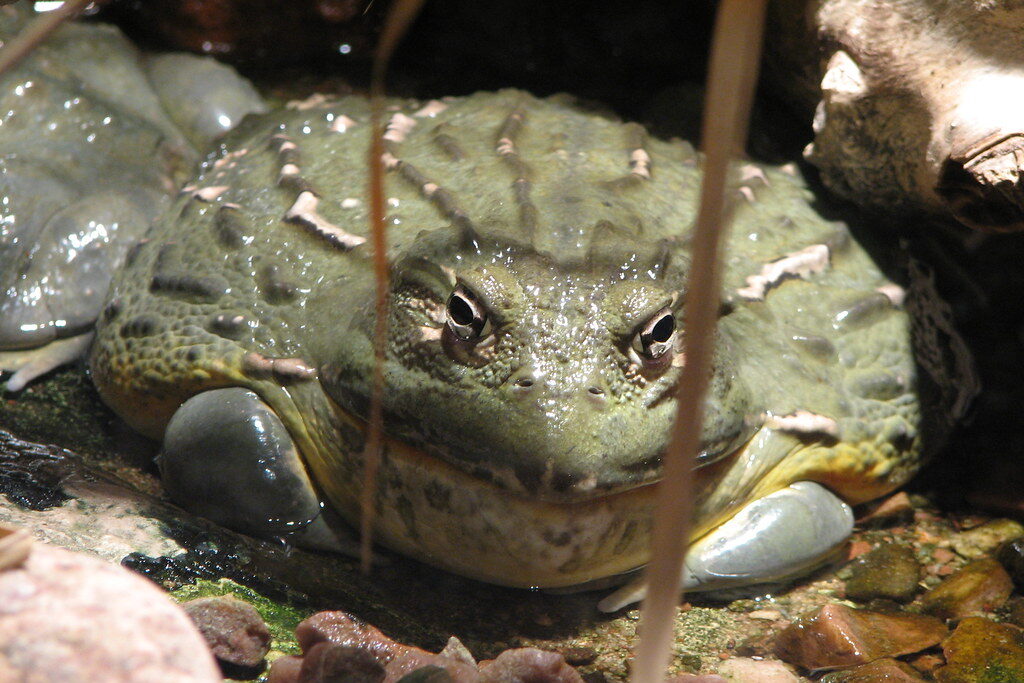
Okay, so check this out! The African Bullfrog is like a giant in the frog world, with some of them growing as long as 10 inches or even more! But here’s the thing, not all of them are gonna be that big – some might be smaller.
Coloration: These frogs come in all sorts of colors, like bright green or different shades of brown, depending on where they live and how old they are. And get this: their skin is rough and covered in tiny bumps, making them look super cool and unique.
Distinguishing Features:
The African Bullfrog’s ability to survive in harsh environments is a testament to its remarkable physiological adaptations. Let’s explore the inner workings that allow this amphibian to thrive in its unique habitat.
African Bullfrogs have changed over time to handle really tough environments, especially in dry places:
Male and female African Bullfrogs aren’t just different on the outside. They also act differently when it comes to reproduction:

African Bullfrogs are interesting animals that live in many different places in Africa. Let’s explore where they live and how they survive in different environments.
Geographical Range:
Imagine Africa, with its many different landscapes, from jungles to deserts. African Bullfrogs, also known scientifically as Pyxicephalus adspersus, live in lots of different parts of Africa.
If we looked at a map of where they live, we’d see spots all over Africa where they make their homes. These spots are in countries like South Africa, Namibia, Botswana, and Zimbabwe. They like living in places where there’s water, especially during the rainy season.
Where You Can Find Them:
South Africa: In the south of Africa, there are lots of African Bullfrogs. The wetlands and grasslands there are perfect for them.
Namibia: If you go west from South Africa, you’ll find Namibia. Even though it’s mostly dry, African Bullfrogs can be found there when it rains and creates temporary pools.
Botswana: Further north, in Botswana, African Bullfrogs live in places like the Okavango Delta, which is a big wetland area with lots of animals.
Zimbabwe: In the east of Africa, especially where there’s water sometimes, you can find African Bullfrogs in Zimbabwe.
These places where African Bullfrogs live aren’t random—they’re really important for the frogs to survive, and they add to the variety of life in Africa.
African Bullfrogs are really good at surviving in lots of different places. They’re tough animals that can handle changes in their environment, like climate change.
They live in different habitats, like grasslands, wetlands, and even deserts.
In Grasslands: They dig burrows to stay safe from the hot sun, and when it rains, they come out to breed in temporary pools.
In Wetlands: Places like the Okavango Delta are great for them because they can find lots of food and breed when it floods.
In Deserts: Even in places like Namibia, where it’s dry most of the time, they wait for rain to make temporary pools, and then they breed there.
African Bullfrogs don’t just adapt to where they live; they also adapt how they act. For example, they burrow underground to escape extreme weather, and they can sleep through dry times until it rains again.
As the world changes, African Bullfrogs show us how nature can adapt and survive. They’re an important part of Africa, and they’re really good at finding ways to live in different places.

The African bullfrog, often known as the Pixie frog, is a fascinating creature when it comes to its diet and hunting strategies. These chubby amphibians are carnivorous and play a significant role in their ecosystem.
African bullfrogs eat a lot and will eat many different kinds of animals. They like to eat bugs like crickets, grasshoppers, and beetles. They also eat small animals like mice and even other frogs. It’s amazing how a big frog like this can be such a good hunter.
These frogs are known for their patience and ambush hunting tactics. These frogs are patient and use surprise attacks to catch their food. They mostly hunt at night and wait for animals to come close. Then they grab them really quickly with their strong jaws.
African bullfrogs are important in their environment because they help control the number of bugs and small animals. This helps keep the ecosystem in balance.
African bullfrogs are big hunters where they live. They eat a lot of animals, which helps keep the number of pests down. This is good for plants and other animals in the area.
African bullfrogs are like the kings of where they live. They keep the number of animals they eat in check, which is important for keeping their environment healthy. For instance, because they eat a lot of insects, they help control bugs that might harm plants and other animals.
When African bullfrogs dig holes to live in, it’s not just for them. These burrows also provide homes for other small animals. This helps make their environment more diverse because different kinds of creatures can live there.
The African Bullfrog, also known as Pyxicephalus adspersus, is a remarkable creature with unique reproductive strategies and a fascinating lifecycle. In this section, we will delve into the intricate world of the African Bullfrog’s reproduction and development.
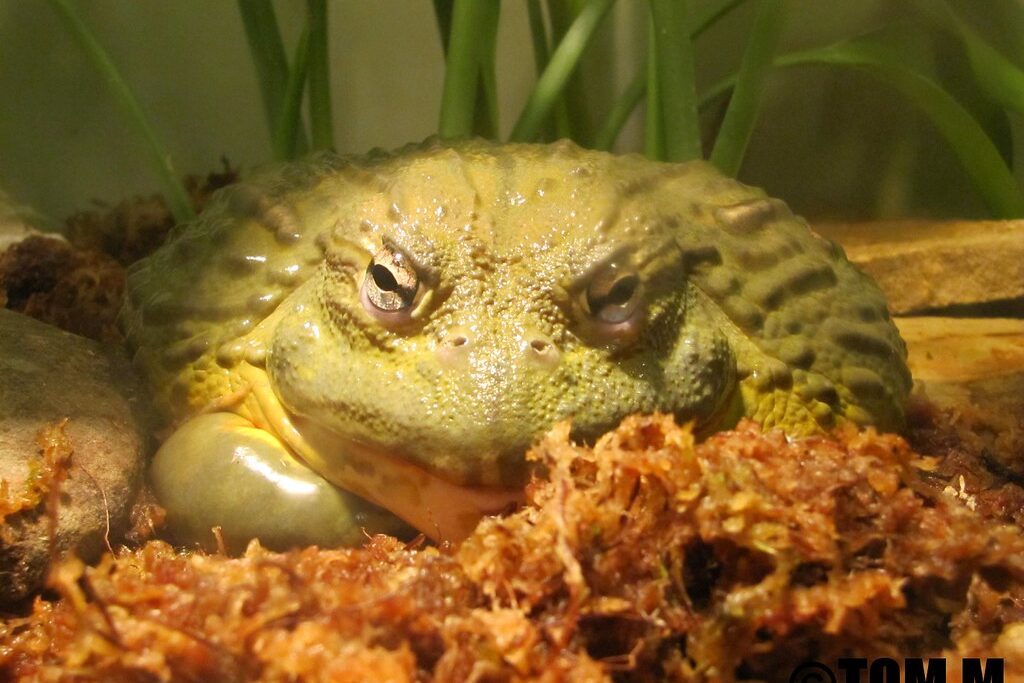
During the rainy season, African Bullfrogs come together near temporary water spots like puddles and ponds to mate. It’s quite a scene to watch the male frogs showing off and making loud calls to mark their territory and attract female frogs.
Once a female is attracted by a male’s calls, they do a special mating dance. The male jumps on the female’s back and holds onto her tightly with his strong front legs. This position helps the eggs get fertilized as the female lays them. It’s a beautiful moment where the frogs work together to make new baby frogs.
The African Bullfrog goes through various stages in its lifecycle:
As African Bullfrogs grow up, they face many challenges at each stage:
When we talk about dads in the animal world, the African Bullfrog really stands out. These special frogs, found in Africa, do something very interesting when it comes to taking care of their babies.
Picture this: a male African Bullfrog watching over its babies very carefully. It’s quite a sight! After the female frog lays her eggs in a shallow pool of water, it’s the male’s job to protect them. He stays close, keeping an eye on the eggs day and night.
What’s really amazing about this isn’t just that the male frog protects the eggs; it’s how much he gives up to do it. For weeks, while the eggs are developing, the male frog doesn’t eat anything at all. Yes, you read that right! He goes hungry to make sure his babies are safe. This kind of dedication to being a parent is really rare in the animal kingdom.
But the male African Bullfrog doesn’t just guard the eggs; he also takes care of them. He uses his back legs to keep the eggs wet, so they don’t dry out and die. His constant attention and care create the perfect conditions for the eggs to turn into tadpoles.
Comparison with Other Amphibians
Now, let’s look at how this compares to what other amphibians do. While many frogs lay their eggs and leave them alone, the African Bullfrog does things differently.
Unlike frogs that leave their eggs in water and let them hatch on their own, the male African Bullfrog stays with the eggs. Other frogs might leave their eggs and tadpoles in ponds or streams, relying on the environment to take care of them. But the African Bullfrog takes charge, making sure the eggs get the best care possible.
Compared to well-known poison dart frogs, which carry their tadpoles on their backs and put them in tree holes filled with water, the African Bullfrog’s dedication to guarding the eggs is really special. Both kinds of frogs take care of their babies, but the Bullfrog’s commitment to staying with the eggs and giving up food for them is unmatched.
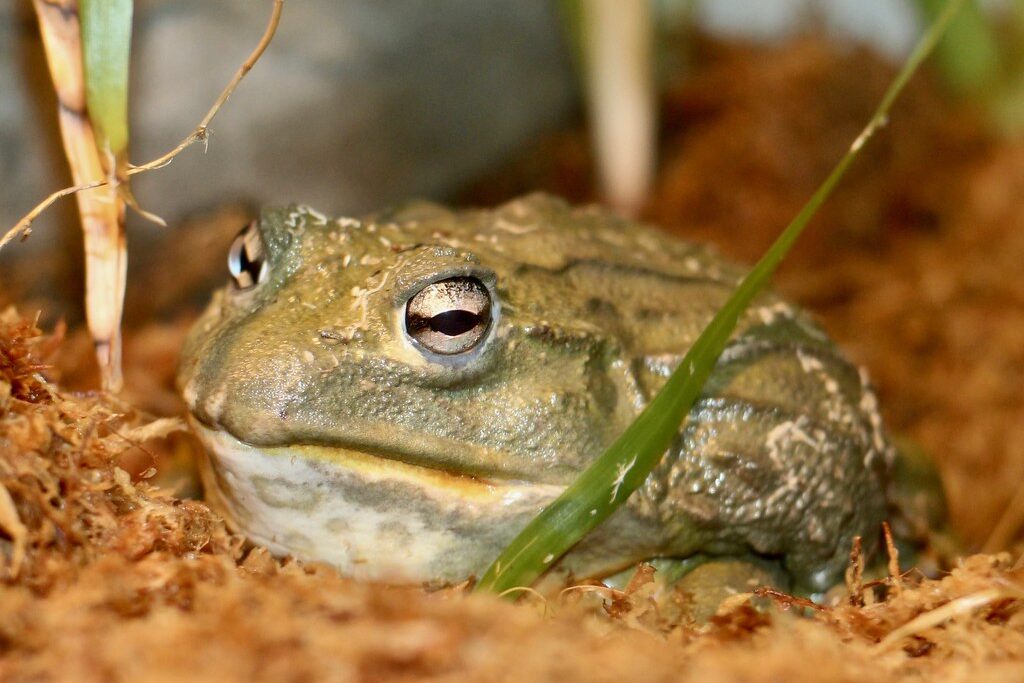
Have you ever thought of frogs as social creatures? Well, the African bullfrog definitely qualifies! During the breeding season, these amazing amphibians gather in large groups, creating a bustling frog community. Let’s dive into some insights into their social structure.
Now that we’ve explored their social side, let’s jump into the intriguing world of African bullfrog communication. These creatures have a language all their own, and it’s nothing short of fascinating.
During mating season near breeding sites, it gets pretty noisy. Male bullfrogs make loud croaks to mark their territory and attract mates. You can hear these deep, booming sounds from far away, and each bullfrog has its own unique call.
Frogs don’t just rely on sounds to communicate; they also use body language. They show aggression and mark their territory with certain poses and displays. This adds another way for them to talk to each other.
When it’s time to court a mate, African bullfrogs have quite the dance routine. The male frog does a fancy footwork dance to impress the female. It’s a lovely show of dedication and romance in the frog world.
African Bullfrogs are cool frogs found in Africa. People who love nature really like them. In this part, we’ll talk about how these frogs are doing in terms of conservation, what dangers they’re facing, and what’s being done to help them.
Conservation Status: African Bullfrogs are currently considered “Least Concern” by experts who look at animal populations. But that doesn’t mean everything’s fine. In some places, there are fewer and fewer of these frogs because of different problems.
Threats: Even though experts say they’re not in big trouble, African Bullfrogs have some serious problems. One big issue is that they’re losing places to live. Cities and farms are taking over their homes, like wetlands where they lay their eggs. Also, the weather changing can mess up when they have babies. And some people catch them too much for pets, which can make it hard for them to survive in the wild.
Conservation Efforts: People who care about these frogs are working hard to keep them safe. They’re making special places where they can live without worrying about getting destroyed. They’re also teaching others why these frogs are important. And some groups are helping them have babies safely in places where they’re kept safe from harm.
African Bullfrogs might not be the first animals you think of when you consider how humans impact nature, but our actions affect them too. Let’s talk about how and what’s being done to help.
Destroying Homes: People building cities and farms are destroying where bullfrogs live. Places like wetlands where they have babies are disappearing fast. This can mess up when they have babies and make it hard for them to survive.
Getting Taken for Pets: Sometimes, people catch these frogs to sell as pets. If too many are taken, it can be bad for their populations. It’s important for people who want them as pets to make sure they’re from places that take care of them right.
Protecting Them: Luckily, there are things being done to keep African Bullfrogs safe. Groups are working hard to tell others why these frogs are important and make rules to stop too many from being taken for pets.
What You Can Do: If you love animals like these frogs, you can help too. You can support groups that help them, tell others why wetlands are important, and if you have one as a pet, make sure it’s from a good place. Even small things can make a big difference in keeping these amazing frogs safe.
African bullfrogs, also known as Pyxicephalus adspersus, are important in African culture and stories. They’re special because they appear in myths and are sometimes considered a fancy food.
In African stories, these frogs represent change and strength. They start as small tadpoles, change a lot, and become big frogs. This is like how people grow and change in life.
Some African communities believe these frogs protect water. Their loud calls can mean rain is coming, so they’re important in ceremonies to bring rain. This helps farmers who need rain for crops.
But some people also like to eat these frogs. They’re caught during rainy times when there are many. However, catching too many can harm the environment.
Additionally, some African communities see African bullfrogs as guardians of water. Their loud croaking is thought to signal that rain is coming, so they’re important in rainmaking ceremonies. In these traditions, people believe the frogs can help bring much-needed rain to dry areas, giving hope to farmers who rely on crops.
However, in other African communities, these frogs are seen as a tasty treat. Their meat is considered fancy in some places. People catch them mainly during the rainy season when there are many. But catching too many frogs worries some people because it might hurt the environment.
The discussion around keeping African bullfrogs as pets has sparked interest among amphibian lovers worldwide. But there are important factors to consider before deciding on pet ownership, such as legal rules, ethical concerns, and the frogs’ care needs.
Legally, whether you can have African bullfrogs as pets depends on where you live. Some places have strict laws about owning wildlife, including amphibians. It’s crucial to know and follow these rules to avoid legal problems.
Ethically, there are considerations about keeping these frogs as pets. They need specific care, like the right temperature and humidity in their homes. It’s generally better to get frogs that were bred in captivity, as taking them from the wild can harm local environments.
Taking care of African bullfrogs as pets requires attention to detail. They need roomy homes with clean water and suitable bedding. Their diet should include insects and sometimes small rodents. You’ll need to do thorough research and be committed to providing the right environment and food for them.
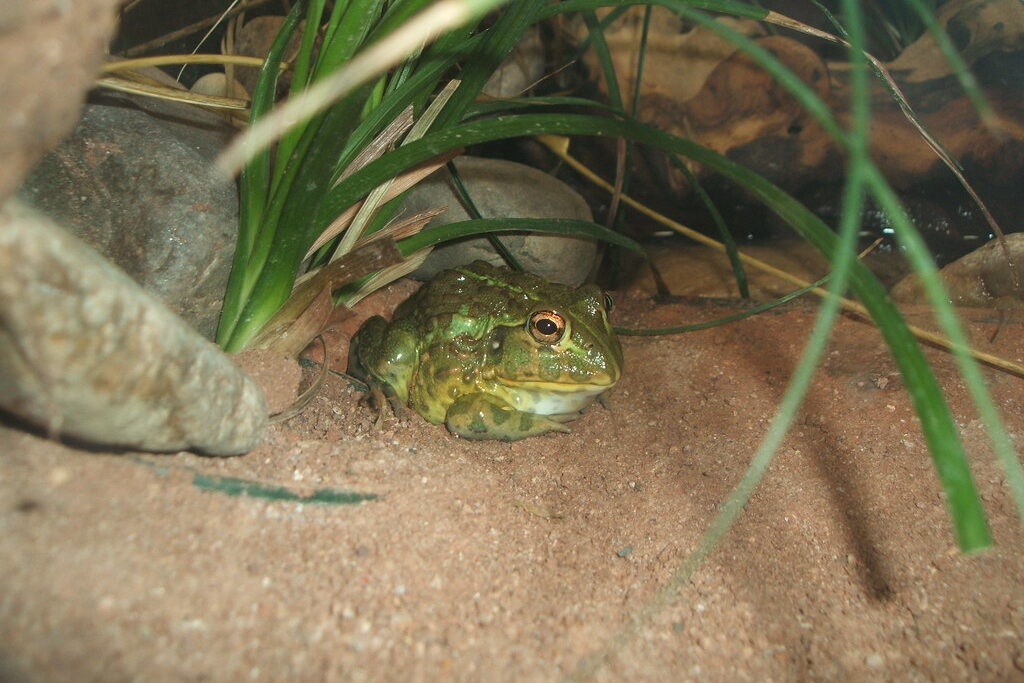
Behavior: Scientists have been studying how African bullfrogs behave. They’ve found that these frogs are skilled hunters and devoted parents. Male frogs are especially committed to protecting their young. They’ll even dig channels to provide water for tadpoles during dry times.
Genetics: Researchers have looked into the genes of African bullfrogs and found interesting things. These frogs have special glands in their skin that produce a mucus helping them retain water in dry places.
Physiology: Scientists are exploring how tough African bullfrogs are. They can survive tough conditions like droughts. Their ability to go into a sort of sleep called aestivation is especially intriguing to researchers.
Looking ahead to the future of African bullfrog conservation, it’s important to recognize both the challenges and opportunities that lie ahead.
Habitat Loss: One of the biggest threats facing African bullfrogs is the loss of their habitats. Urban development and agriculture are major causes. To conserve these frogs, efforts need to focus on preserving their natural homes.
Community Engagement: Getting local communities involved is vital for successful conservation. Programs that include people living near the frogs and their habitats can be very effective.
Global Collaboration: Working together on a global scale is crucial. Organizations and individuals around the world are teaming up to protect African bullfrogs and the places they live. Getting involved in these efforts can have a real impact.
Are you ready to make a difference in the conservation of African Bullfrogs? Let’s talk about how you can get involved in citizen science and contribute to their preservation.
Why African Bullfrogs Matter
Joining Conservation Initiatives
Participating in Data Collection
Educating and Raising Awareness
Supporting Habitat Protection

Now, let’s explore how you can ethically and responsibly observe African Bullfrogs, whether in their natural habitat or in captivity.
The conservation journey of the African bullfrog, a remarkable amphibian species, is fraught with challenges amplified by climate change and expanding human activity. Let’s delve into the complexities of preserving these captivating creatures and the obstacles they face.
Climate change poses a significant threat to the African bullfrog’s habitat. Rising temperatures are altering their environment, forcing them to adapt rapidly or face extinction. Their semi-arid habitats are becoming drier, posing survival challenges. More frequent droughts and changing rainfall patterns can lead to water shortages, impacting their breeding sites.
The natural habitats of African bullfrogs are under pressure from expanding human activities. Urbanization, agriculture, and infrastructure development are fragmenting their habitats, hindering their movement and ability to find suitable breeding areas. Pollution from human sources further degrades water quality, putting their survival at risk.
Invasive species are another threat to African bullfrogs. Non-native predators and competitors can disrupt the fragile ecosystems where these frogs thrive. Conservation efforts must include strategies to control or eradicate invasive species to protect the native populations.
To secure the future of African bullfrogs, it’s crucial to identify research areas that can guide effective conservation strategies. Let’s delve into some exciting research opportunities and how they can influence the conservation of these unique amphibians.
Research should focus on understanding how African bullfrogs can adapt to changing climates. This involves studying their physiological responses to temperature variations and identifying genetic traits that confer resilience. Such insights can inform habitat restoration efforts and captive breeding programs.
Efforts to restore degraded habitats are paramount. Research can help identify the most effective methods for habitat restoration, including reintroducing native vegetation, managing water resources, and creating buffer zones to reduce human disturbance.
Disease outbreaks can devastate amphibian populations. Research into diseases affecting African bullfrogs can lead to the development of preventive measures and treatments. Monitoring the health of wild populations and implementing biosecurity measures in captive breeding programs is crucial.
Engaging local communities in conservation efforts is vital. Research can assess the socio-economic factors affecting African bullfrog habitats and develop sustainable livelihood alternatives that reduce pressure on their habitats.
Studying the genetic diversity of African bullfrog populations is essential. Maintaining genetic diversity is crucial for their long-term survival. Research can guide breeding programs to prevent inbreeding and preserve the species’ genetic heritage.
The changing climate presents new hurdles for the resilient African bullfrogs, scientifically known as Pyxicephalus adspersus. Here’s how they’re impacted:
Temperature Extremes: African bullfrogs, typically found in semi-arid regions, now contend with more frequent and severe temperature swings and prolonged droughts. These shifts disrupt their breeding habits and reduce available water sources.
Altered Rainfall Patterns: Erratic rainfall patterns disturb their breeding cycles, as they rely on temporary ponds for reproduction. Climate-induced changes can lead to fewer breeding opportunities and lower reproductive success rates.
Habitat Loss: Desertification shrinks their habitats, depriving them of essential areas for breeding and feeding. As their habitats diminish, so do their chances for survival.
Despite facing significant challenges, African bullfrogs employ remarkable survival strategies:
These frogs aren’t just biologically intriguing; they also hold significant cultural importance in various African societies. Here are a few examples:
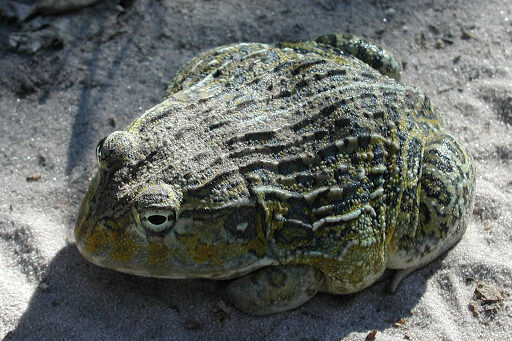
Let’s broaden our perspective and compare African bullfrogs with other large frog species from different continents:
| Species | Location | Size | Behavior and Adaptations |
| African Bullfrog | Africa | Up to 9 in | Estivation, Cannibalism, Vocal |
| Goliath Frog | Central Africa | Up to 12 in | Powerful Legs, Aquatic Lifestyle |
| Cane Toad | Australia | Up to 4.3 in | Poisonous Glands, Invasive |
| American Bullfrog | North America | Up to 8 in | Highly Vocal, Invasive |
African Bullfrog populations have been significantly affected by the pet trade. Let’s delve into the details:
For those considering African Bullfrogs as pets, here are comprehensive guidelines for their care:
Now, let’s gain insights from experts who have dedicated their lives to studying and conserving African Bullfrogs:
When it comes to African Bullfrogs, one of the most frequently asked questions is whether they are venomous. Let’s explore this intriguing aspect.
Yes, African Bullfrogs can be venomous because of the toxins in their skin secretions. They have special glands in their skin that make these toxins. But don’t worry, the toxins usually aren’t strong enough to harm humans. These toxins help them defend against enemies, making them tough creatures in their home.

The venom from African Bullfrogs might make your skin or mucous membranes feel irritated or uncomfortable. It could even cause mild allergic reactions. While it’s usually not dangerous, it’s important to handle these frogs gently and avoid touching them directly with your skin.
Now that we’ve explored their venomous nature, let’s take a closer look at their temperament and whether they can be considered friendly.
African Bullfrogs aren’t exactly known for being friendly. They’re often seen as aggressive and territorial. When it’s breeding season, male frogs can get really territorial and might even act aggressively towards other frogs, including ones of the same species.
If you’re thinking about having African Bullfrogs as pets, it’s important to handle them carefully. Always wear gloves to protect yourself from their skin secretions, and remember they can be aggressive, especially if you keep more than one together.
Sure! African Bullfrogs are different from other frogs because they like to eat meat. Let’s talk more about how they hunt and what they eat.
African Bullfrogs mostly eat meat. They like to munch on insects, small rodents, and even other frogs. They’re not picky eaters and will gobble up whatever they can find. They’re always on the lookout for food and can eat a lot in one go.
These frogs are really good hunters. They use a clever trick called the sit-and-wait strategy. They hide in burrows or in shallow water, staying out of sight. Then, when a tasty snack gets close enough, they pounce! Their strong jaws and fast reflexes help them catch their prey easily. They’re like skilled hunters in their own world.
The African Bullfrog, scientifically known as Pyxicephalus adspersus, is a charismatic amphibian that can be found across the savannas and grasslands of sub-Saharan Africa. With its distinctive appearance and behaviors, it’s hard not to be captivated by this incredible creature.
The African Bullfrog plays a vital role in maintaining the delicate balance of its ecosystem. As voracious predators, they help control insect populations, preventing crop damage and diseases. By doing so, they indirectly support local agriculture and human livelihoods.
These frogs are ecosystem engineers. Their burrows provide shelter for a multitude of other species during harsh weather conditions and predators. In essence, they shape the very landscape they inhabit, making them keystone species.
Beyond its ecological significance, the African Bullfrog holds a special place in the hearts of many indigenous communities. For centuries, it has been a symbol of strength and resilience, featuring prominently in folklore and rituals.
In some African cultures, the call of the African Bullfrog is believed to be a harbinger of rain, a blessing for drought-stricken regions. Its symbolic presence in rituals and ceremonies underscores its deep-rooted importance in local traditions.
Now, let’s shift our focus to the essential aspects of conservation, education, and ethical engagement in preserving this incredible species.
To ensure the survival of the African Bullfrog, education is key. Raising awareness about its importance in the ecosystem, its cultural significance, and the threats it faces is crucial. It starts with people like us sharing our passion and knowledge.
Supporting organizations dedicated to amphibian conservation is a tangible way to make a difference. These groups work tirelessly to protect the habitats of the African Bullfrog and other endangered species. By contributing or volunteering, you can be part of the solution.
Responsible pet ownership is another critical aspect. While the African Bullfrog may be alluring as a pet, it’s essential to ensure that captive breeding is done ethically, without harming wild populations
Now that you’ve learned about African Bullfrogs, I urge you to consider supporting their conservation efforts. Here are some ways you can make a difference: